Over the past two weeks I have covered a few topics about athlete monitoring and how volume and intensity both tie into monitoring.
We started the topic by discussing that as coaches our job is first and foremost to be stress managers. When we look at volume and intensity we need to remember that they are ways in which we are placing stress upon an athlete or client. Too much of one or the other and we can do serious harm. Especially if that athlete or client is already not in an optimal training state.
When I look at volume I think of its application to the nervous system and how the athlete can recover. We know from the textbooks and research that lifts with higher volume will take the athlete anywhere from 24 to 48 hours to recover from. However, lifts that are higher in intensity with lower volume are easier for the body to recover from (12 to 24 hours). On a quick side note this is why you want your in-season lifting programs to be more strength focused.
Now how can use this information and pair it with a few quick, easy and cheap athlete monitoring tools. Don’t get me wrong I would love to have all my athletes use HRV or an Omegawave however the cost of these tools compared with the lack of compliance I would get just does not work for my personal situation. Our first athlete monitoring tools is a jump mat. While the athletes think we are monitoring them for vertical improvements we are actually getting a history to create a data set so we can have a CNS/power output number. If they perform a counter movement jump (CMJ) that is more than 10% of their average then we will take volume off the lift.
The second tool we use are in-season workout cards that are color coded like a stop light. However we invert the color meaning Red will be a hard workout, Yellow a moderate and more CNS focused lift, and Green meaning I feel terrible and need an aid to recover. I love this because after jumping and grabbing their card they have to ask us which day they should do. The beauty of this is it opens the door for our coaching staff to ask questions that would normally be on a readiness questioner. Now our athletes that are veterans of our program understand the cards and questions we will ask and can pick their days on their own.
The last tool we will use is the Polar Team app and their H7 monitors. We use these to watch the heart rate for abnormalities during training. For instance, last week we had a player come back after being sick and lifting for a day. I noticed that during foam rolling before the workout his heart rate was up 10 beats per minute from his usual. We discussed sleep and how he was feeling and determined we should do a regeneration day instead of our planed upper body lift.
I love these three tools not because it’s science and it adds value to our programs at ProForce Sports Performance, but because it opens up dialogue between athlete and coach. It also gives the athlete data to help trust the coach in the process that is training. It’s hard enough to lead the horse to water. The data and dialogue is what I have found helps the horse drink the water.
If you have questions or comments feel free to email me.
By: Kevin Hollabaugh, MHA, CSCS, USAW, FMSC, CSAC
Khollabaugh@proforcesp.com

